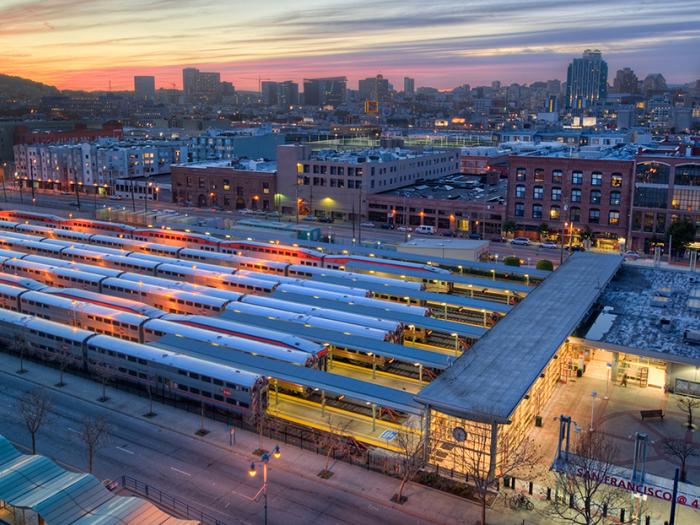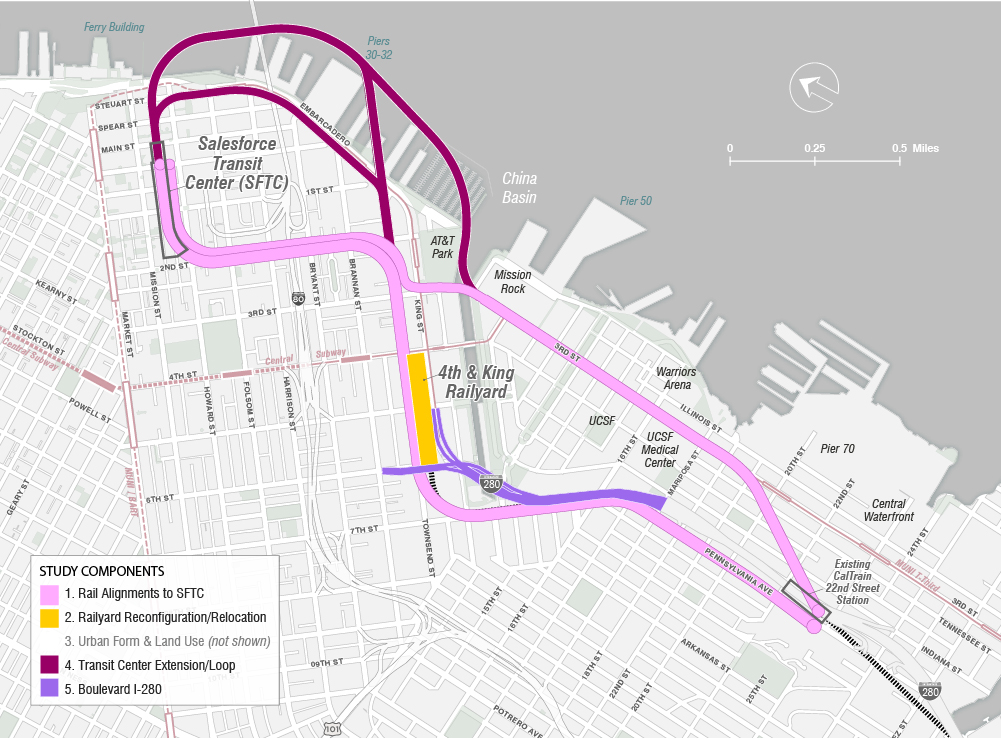
Railyard Alignment and Benefits Study
The Rail Alignment and Benefits (RAB) Study analyzed the best ways to bring Caltrain and High Speed Rail to the Salesforce Transit Center while connecting San Francisco's fastest-growing neighborhoods on the east side of the City.
To coordinate and support efforts of Caltrans, Caltrain, High Speed Rail, the Transbay Joint Powers Authority, the RAB Study includes 5 components:
1. Rail Alignment into the Salesforce Transit Center (SFTC)
This component seeks to answer the most time sensitive question of the RAB: how to bring both Caltrain and High-Speed Rail from the county line into the Salesforce Transit Center.
2. Railyard Reconfiguration/Relocation
This component considers reknitting the fabric of the City by modifying or relocating some or all of the activities at the 4th/King Railyard.
3. Urban Form and Land Use Considerations
Relocating the Caltrain Railyard and/or other infrastructure changes could make new land available for the restoration of the street grid, improved bike/pedestrian connections, elimination of rail hazards and noise, and construction of housing, commercial development, and open space. This component considers these issues at a conceptual level and provides a baseline for future study.
4. Transit Center (SFTC) Extension/Loop
This component explores future scenarios for train connections and operations beyond the initial connection to the SFTC to improve station capacity and/or rail connections beyond SFTC to the East Bay or back down the Peninsula.
5. Boulevard I-280
This component analyzes the interaction between proposed rail alternatives and the I-280 structure to ensure that the rail alignment does not preclude the possibility of future changes to I-280 north of Mariposa.
See Supporting Info tab for latest details.
Public Meetings
May 29, 2018: Public Meeting
A public meeting was held to summarize the findings from the RAB study, including a preliminary preferred alignment for Caltrain and High Speed Rail: the Pennsylvania Avenue (DTX + Extended Tunnel). Community members were invited to provide input on the alignment, adjacent land use opportunities, and next steps. Provided below are the materials that were presented at the public meeting (additional materials will be added at a later date):
- Presentation
- Boards and Handouts
- Rail Alignment and Benefits Study:
- Final Executive Summary Report September 2018 (Planning Department)
- Final Consultant Technical Report
- Appendix A: Conceptual Design Drawings, Alignment Alternatives
- Appendix B: Conceptual Design Drawings, Loop Alternatives
- Appendix C: Operations Analysis (RAB Operations Sketch Planning Analysis)
- Appendix C: Operations Analysis (Conceptual Planning Analysis)
- Appendix D: Economic Analysis of Rail Alternatives ( Land Value Analysis)
- Appendix D: Economic Analysis of Rail Alternatives (Financing Opportunities)
- Appendix D: Economic Analysis of Rail Alternatives (Secondary Costs Analysis for RAB Alternatives)
- Appendix E: Basis for Comparative Cost Analysis
- Appendix F: Traffic Analysis, I‐280
- Appendix G: Rail Relocation Land Use Analysis
- Appendix H: Additional Technical Analysis – Soil Conditions & Geologic Hazards, Tunneling, and Fire Life Safety
- Appendix I: Index to Document Library
List of Meetings attended, Meeting minutes, letters received and comment provided
March 28, 2018: Citizen Working Group - Meeting #6
February 23, 2016/March 30, 2016: Community Discussion on the first phase of the Railyard Alternatives and I-280 Boulevard Feasibility Study
- Presentation
- Poster Board - comments collected at meeting
- Poster Board - questions and answers collected at the meeting
- Fact Sheet
San Francisco Planning established a Citizens Working Group (CWG) for the RAB study in the summer of 2016. The CWG is comprised of citizen stakeholders who represent the broad interests of the communities surrounding the Caltrain right-of-way, the Caltrain railyard, the Salesforce Transit Center (SFTC) – previously known as the Transbay Terminal Center.
Members participate in meetings designed to better understand the intricacies of the Study, distribute information to the public, help identify community priorities and concerns, and provide context for recommendations and updates to the second phase of the Study. All CWG meetings are open to the public. Learn more about the CWG Roles and Responsibilities.
| MEETING DATE | LOCATION & DETAILS | MINUTES | MATERIALS |
|---|---|---|---|
| 2018, May 21 6:00 - 8:00 p.m. |
Location: Mission Creek Senior Community Center 225 Berry Street San Francisco, CA 94158 Topic: Study update and preparation for public meeting |
|
|
| 2018, March 28 6:00 - 8:00 p.m. |
Location: Firehouse #30 Community Room 1275 Third Street, San Francisco, CA 94158 Topic: Study update |
Meeting Minutes | |
| 2017, March 2 6:00 - 8:00p.m. |
Location: Mercy Housing Community Room 1180 4th Street San Francisco, CA 94158 Topic: Study update, CWG questionnaire results, and a discussion around public workshop planning |
Meeting Minutes | |
| 2016, December 6 6:00 - 8:00 p.m. |
Location: Firehouse #30 Community Room Topic: Review of matrix of benefits, impacts, and schedule implications for options of each component, discussion of tradeoffs. |
Meeting Minutes | |
| 2016, October 18 6:00 - 8:00p.m. |
Location: TBD Topic: Community values and a review of the remaining three components of the study. |
Meeting Minutes | |
| 2016, September 19 6:00 - 6:20 p.m. closed to CWG members only 6:30 p.m. open to the public |
CWG Members Only Location: Held off-site Topic: 4th & King station overview of operations Open to the Public Location: Mercy Housing Community Room 1180 4th Street, San Francisco, CA 94158 Topic: Review analysis from Phase I, discuss goals and select CWG Chair |
Meeting Minutes | |
| 2016, August 1 6:00 p.m. |
Location: Firehouse #30 Community Room 1275 Third Street, San Francisco, CA 94158 |
Meeting Minutes |
For comments or suggestions:
Jeremy Shaw
Principal Planner
jeremy.shaw@sfgov.org
628.652.7449
Patrick Race
Senior Planner
patrick.race@sfgov.org
Agency Coordination
The study's technically advisory committee (TAC) included representation from the Metropolitan Transportation Commission (MTC), Caltrans, California High Speed Rail Authority (CHSRA), Caltrain, Transbay Joint Powers Authority (TJPA), California State Transportation Agency (CalSTA), Federal Transit Administration (FTA), Federal Railroad Administration (FRA) and various City and County Departments including: San Francisco Planning, San Francisco County Transportation Authority (SFCTA), San Francisco Port Authority, San Francisco Municipal Transportation Agency (MTA), San Francisco Department of Public Works (DPW), San Francisco Office of Community Investment and Infrastructure (OCII), San Francisco Office of Economic and Workforce Development (OEWD), and the San Francisco Mayor's Office.
The San Francisco Planning Department contracted with international engineering firm CH2M Hill (now Jacobs) to aid the City in this effort.
Funding
The study currently received approximately $1.7 million through the following:
- Two MTC Priority Development Area (PDA) competitive planning grants of $519,940 (Phase I) and $700,000 (Phase II)
- Strategic Growth Council (SGC) Sustainable Communities Planning grant of $490,672 (Phase II)
- Planning General Funds $125,000 for additional rail operations sketch modeling (Phase II)

